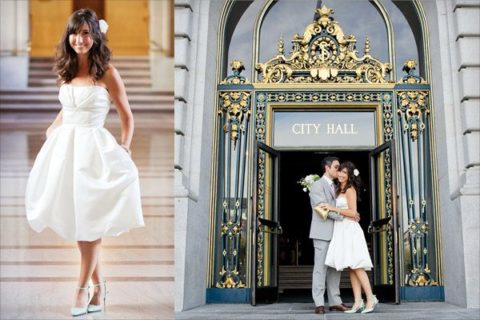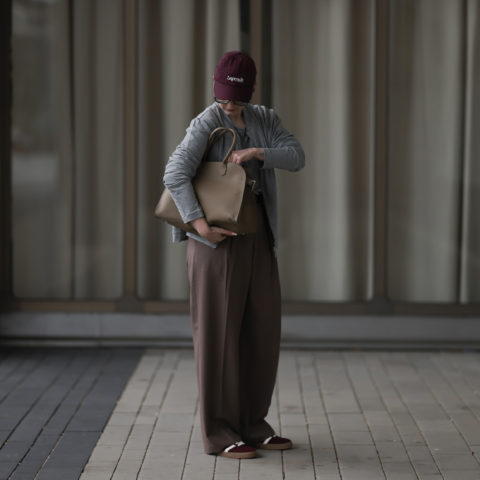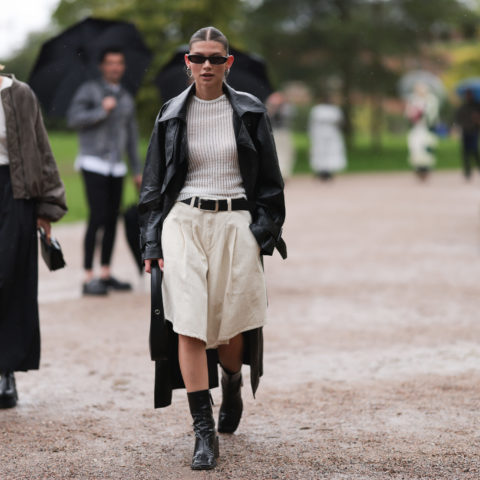Vow Factor: Olivia Stren goes shopping for a wedding dress and discovers her perfect match isn’t tied up with bows


By Olivia Stren
I’m in wedding empress Ines Di Santo’s Toronto boutique, fondling a frothy, aisle-long expanse of Chantilly lace, Italian silk and doppia faccia (double face) Italian satin—a decadent marriage between peau de soie and taffeta. “It feels like orchid petals,” says Di Santo, caressing it. “To know a gown, you have to feel it,” she tells me in a seductive rasp. “How do you know the man you’re going to marry? You have to feeeeel him. The same goes for a dress.”
We sit on a gold-framed divan, the kind of perch that looks designed for fainting, nibbling on petits fours or getting fanned by manservants. There are no men here, though, and one gets the sense there never are. Di Santo’s couture dresses—also for sale at New York’s swish Bergdorf Goodman department store—are lavish, theatrical scene-stealers redolent of the designer’s childhood in Buenos Aires during the 1950s and ’60s. “I remember going to the theatre with my papa and a handsome actor pulled up in a Rolls-Royce, and I thought, ‘Everybody should always look like that—fancy,’” she says. Her first fashion show in Toronto was appropriately dramatic; she rented Casa Loma and had a tiger escort her models down the catwalk. “I see beauty everywhere,” she says. “My husband tells me, ‘All I see is a rock, and you see what it would look like drizzled with rose petals.’” She tells me what she saw when she first saw me: “I see a New York night wedding at a glamorous restaurant and you in a long Chantilly lace gown.” (I’m getting married during the day at City Hall in San Francisco in a knee-length cocktail dress.)
Di Santo is, she explains, in the business of making dreams come true. But I was never one of those girls who dreamed about her wedding day. I’m sorry to add that it was by no means because I was focused on more virtuous or sensible pastimes; I just preferred to view marriage as an ending, rather than a beginning. So thoughts of the Big Day, freighted with the suffocating weight of Forever, were generally wed to a bridal party of neuroses; the festive theme of my outlook was summed up nicely once by actor Jeff Bridges, who said about his marriage: “I thought it was a giant step toward death.”
Since I recently decided to take that giant step, I also resolved to adopt a somewhat sunnier stance on the institution. And when the time came to plan my nuptials, one image leapt to mind: a 1950 photograph by French photographer Robert Doisneau of a handsome couple walking arm-in-arm past a flower stand in Paris. This photo adorned my childhood bedroom. She’s wearing a full-skirted trench coat, smiling and holding a delicate bouquet; he’s holding her, kissing her cheek. It’s unclear where Doisneau’s amoureux are coming from or going toward, but I imagined that they had just come from the courthouse. To me, it’s the image of joy and hope and vitality and promise: lovers at the beginning of something. The city in the background also seems happy, going freely about its own rhythms. Although legalities interfered in our attempts to do the knot-tying at a European courthouse, we settled on San Francisco’s City Hall. (Marilyn Monroe and Joe DiMaggio married there in 1954; the actress sported a curve-hugging, fur-trimmed brown wool tailleur.)
I started the search for my outfit at White, a bridal store in Toronto’s Yorkville area, where salesclerks shimmy around with all the adrenalin of handmaidens to a queen in her honeymoon boudoir. “Are you excited?” the salesclerk asked me. “You must be SO excited!” The real stress, it seems, in getting married is the pressure to be feeling excited at all moments. Which is not to say there was no excitement involved, but it was liberally laced with anxiety and an overlay of financial alarm. I was escorted to a suite where a tray of cookies and chocolates was waiting to greet and woo. The dress-shopping experience is a kind of retail foreplay; a seduction in its own right, with the bridal consultant or designer serving as matchmaker, coaxing confessions about hopes and fantasies, and the bride indulging in a culturally sanctified fling with her own vanity. The moment bride meets gown is meant to be its own fashion coup de foudre—a full-hearted, tearful moment of satisfaction and relief. Then comes commitment and plastic-swiping. At White, that moment is also celebrated with a champagne toast.
As I slipped on a tea-length organza dress by Ivy and Aster, an extravagantly bejewelled cap-sleeve number by Jenny Packham and a high-glam halter-top creation by Nicole Miller, the salesclerk asked me: “How do you feel? Do you feel like a bride?” I gathered from her tone that this was the desired feeling. But the problem was, I did feel like a bride, or at least a version of one, and was therefore not remotely recognizable to myself. Said gowns and I lacked chemistry. I left dressless and deflated, like I had just gone on a bad date. About a month after this experience, I wandered past Cabaret, a vintage store on Queen Street West in Toronto. I popped in on a whim and tried on a 1950s-style cocktail dress with the kind of cinched waist and full skirt that reminded me of Audrey Hepburn’s Givenchy wedding dress in Funny Face—the actress looking almost unbearably resplendent in a boat-neck tulle confection, her waist about as tiny as an engagement ring. Pity I’m no Audrey. But love is blind—and, besotted, I bought the dress. Weeks later, when I found myself at Di Santo’s, touching a rack of swiss-dot-embroidered tulle and Swarovski-crystal-adorned bodices, suddenly fantasizing about how we might look together—maybe we’d be a better team?—I felt like I was partaking in something untoward. “Once you’ve made your choice, it’s done,” the salesclerk instructed me firmly when she discovered I already had a dress. “You stop looking.” Right.
I made my choice, and we were happy together. But if the dress was simple and without adornment, the day itself was generously accoutred with incident. The officiant repeatedly mispronounced our names. I had ordered a bouquet of lily of the valley, but the florist delivered the kind of waxy, stiff, beribboned arrangement you’d expect in a Texan funeral parlour. A close, problem-solving friend rushed across the street to a local flower market and assembled a fresh bouquet.
Post-vows, as we pushed through City Hall’s heavy doors into a busy city street in the lively prime of its afternoon, I felt—with the dress and husband I chose, and the flower-stall bouquet I didn’t—that we were, at least for a moment, like the Doisneau couple. Heading who knows where. At the beginning of something.







